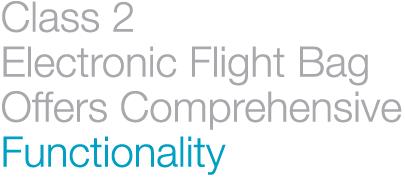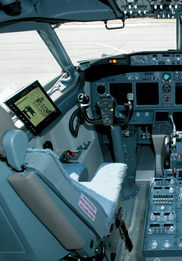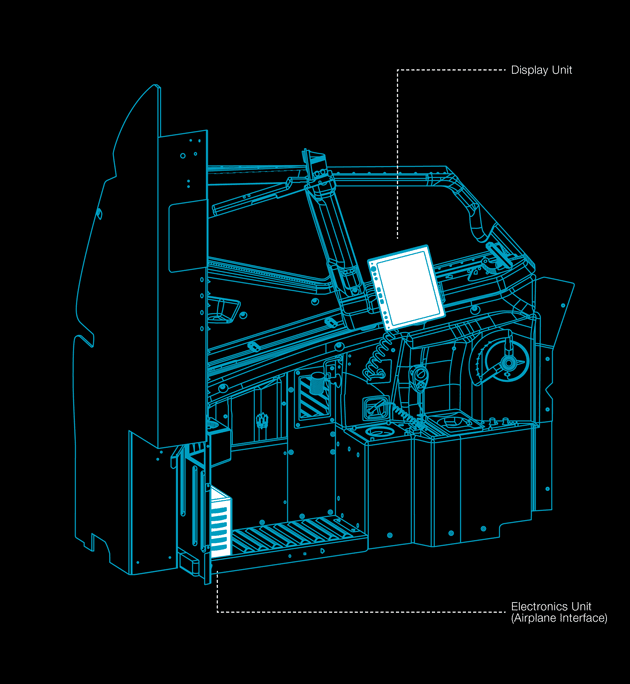

Boeing is leveraging its Class 3 Electronic Flight Bag (EFB) experience to provide airlines with a Class 2 EFB with similar functionality with the current fully integrated Class 3 offering. Boeing estimates that the Class 2 EFB can potentially save operators approximately US$80,000 to US$115,000 per airplane per year by increasing their operational effectiveness. It is initially available on the Next-Generation 737, both in production and for retrofit.
By Ed Tobon, Electronic Flight Bag Product Specialist
The new Class 2 EFB helps airlines increase operational efficiency while enhancing safety and security.
Boeing is offering a common application suite and ground infrastructure for use across Class 1, Class 2, and Class 3 to maximize the value of the EFB infrastructure. Boeing delivered its first Class 3 EFB in October 2003, its first Class 1 EFB in December 2009, and is offering a Class 2 EFB in production and for retrofit starting with the Next-Generation 737. Other models will follow based on operator demand.
This article provides background about the development of Boeing EFBs, describes the features of the new Class 2 EFB offering, and outlines some of the advantages it offers to operators. (More information about the Boeing Class 3 EFB and Electronic Logbook can be found in AERO second-quarter 2008.)
THE EVOLUTION OF BOEING EFBs
The goal of an e-Enabled airline is to connect everything and everyone to a single secure network designed to help the airline meet its business and operational objectives. The EFB system creates a link between the airplane and the airline enterprise. This link, coupled with the software applications on the ground and in the EFB, allows airlines to realize fuel cost savings, enhanced safety and security, reduced insurance premiums, fewer flight schedule delays, and less document handling.
Since Boeing delivered the first Class 3 EFB certification and integration in 2003, approximately 75 percent of 777 airplanes are being equipped with EFB systems during production. The Class 3 EFB is a basic offering on the Boeing Business Jet and 787, and it is a production option on the 777, Next-Generation 737, and 747-8. The Class 3 EFB is also a retrofit option for 747-400, 757, and 767. More than 1,200 airplanes are scheduled to use Boeing Class 3 EFBs.
Understanding that a complete airline fleet solution for EFBs can include multiple classes, Boeing has developed Class 1 and 2 products that complement its Class 3 EFB. Common EFB applications run on multiple classes, depending on operator requirements.
Boeing Class 1 and 2 EFBs provide a common look and feel to the Class 3 EFB. They use the same application software packages and common ground support and administration software. This commonality allows operators to utilize common EFB infrastructure and processes when deploying mixed-class EFBs across the fleet. This also significantly reduces cross-training requirements. In addition, operators can load their own or third-party applications on to any of the EFB classes.
Boeing Class 2 EFB
The new Class 2 EFB is a comprehensive, fully integrated system that offers the following features:
- Class 2 hardware and wiring installed in production or as a retrofit kit (initially for the Next-Generation 737).
- Hardware system (i.e., electronic and display units).
- Flight crew power cutoff switch for EFB system.
- Core software.
- Application manager.
- Maintenance.
- Security and communication.
- Integration with same airplane systems as for Class 3.
- Integration with Class 2-hosted communication systems.
- An integral terminal wireless local area network unit (802.11b/g) capability with an antenna contained in the display unit (see fig. 1).
Figure 1: Next-Generation 737 Class 2 EFB installation and location
In response to feedback from operators, Boeing installs Class 2 EFB display units in a location that provides easy access and a good viewing angle for the pilot.

Product support for the new Class 2 EFB includes:
- Maintenance documentation.
- Operations documentation.
- Maintenance and operational training.
- Operational approval assistance.
- Technical support 24 hours a day, seven days a week.
- Hardware warranty.
- Spare parts.
The Class 2 EFB offers the same hardware in production and for retrofit, with the Next-Generation 737 being the first model supported. The system is fully integrated with flight deck and airplane systems.
In response to customer requests, the location of the Class 2 EFB Next-Generation 737 flight deck does not require a new sidewall or relocation of the oxygen mask, both of which can add to the cost of the installation. The location also provides easier access to the EFB and allows the pilot to view information without looking down (see fig. 1).
Class 2 EFB software applications
Several software applications will be available for the EFB from Boeing and Boeing subsidiary Jeppesen. These modules enable operators to customize the EFB for their particular operations. Operators can add these software modules during initial installation or at any point in the future. Each provides increased operational efficiency to airlines (see fig. 2).
- Airport Moving Map provides high-resolution airport diagrams with own-ship position. Airport databases with global-positioning-system tracking depict the airport environment with a high degree of accuracy and visual detail.
- Electronic Charts offers clear, concise airport, airspace, and approach charts; standard instrument departures; and standard terminal arrivals. The worldwide coverage can be customized to provide specific content for individual operators.
- Electronic Documents gives access to up-to-date information, reducing lookup times and eliminating sources of error. It incorporates Boeing-provided and customer-originated and -controlled documents. Documents are available in both day and night formats.
- Onboard Performance Tool provides airplane performance calculations that airlines need to optimize the performance of their airplanes. The onboard performance tool automatically factors in minimum equipment list and configuration deviation list items into all calculations.
- Electronic Logbook works with Boeing Airplane Health Management to monitor and forward in-flight fault information to the appropriate ground maintenance facility before the airplane arrives at the gate (see AERO third-quarter 2007).
- Electronic Flight Folder enables airlines to collect data, assemble the initial flight folder, and transmit it to the EFB. The flight folder is populated with flight information and airplane system data and includes the means for the crew to review and digitally sign it.
- Video Surveillance is integrated into EFB, enabling the crew to monitor activity outside the flight deck and in the cabin while in a normal seated position. EFB accommodates a variety of third-party camera systems.
Boeing also provides a software development kit under a separate license that allows an airline to load its own or third-party applications. In addition, the system is designed to provide significant growth and expansion opportunities to add future applications.
Figure 2: Operational value of Boeing Class 2 EFB software applications
| |
Software Option |
Value |
Airport Moving Map (as available) |
|
|
Electronic Charts |
|
Onboard |
|
|
Electronic Logbook |
|
|
Electronic Flight Folder |
|
|
Video Surveillance |
|
Benefits to operators
Like the Class 3 EFB, the Class 2 EFB offers a number of benefits to operators, in terms of flight and maintenance operations as well as safety and cost. The overall increase in operational effectiveness can potentially save operators approximately US$80,000 to US$115,000 per airplane per year, depending on the airline’s technical expertise, infrastructure, number of flights, flight patterns, and other factors considered in Boeing’s cost-benefit analysis.
Flight Operations
The Boeing Class 2 EFB can improve fuel burn performance, help produce higher revenue by optimizing payloads, enhance flight operations’ response to the day-to-day events reported by pilots, and reduce usage of the airplane communications addressing and reporting system. It can also increase pilot efficiency, partly by eliminating the need for them to manually enter pilot reports.
Maintenance Operations
The greater accuracy of pilot reports increases mean time to failure and mean time between overhaul for components. The Class 2 EFB also eliminates transcription of pilot reports into another computing system and reduces technical schedule interruptions, no-fault founds, inventory, and line maintenance labor. The result is lower airplane out-of-service costs, increased dispatch reliability, improved correlation between faults reported and maintenance, and increased regulatory compliance.
Safety
The Class 2 EFB, with its available airport moving map, makes accessing an airport layout map easier for pilots than searching for a paper map. It also increases familiarity with each airport’s layout, enhances taxi situational awareness, and reduces the probability of runway incursions. It also helps ensure the appropriate takeoff and landing speeds based on runway conditions. For added safety inside the airplane, video surveillance provides increased visibility to cabin and flight deck door area activity.
Cost
The Boeing Class 2 EFB can reduce costs by lowering insurance premiums and increasing operational effectiveness through improvements to flight and maintenance operations.
SUMMARY
Boeing EFBs help airlines increase operational effectiveness while enhancing safety and security. The new Class 2 EFB reflects Boeing’s commitment to develop several EFB platforms that can be installed on any airplane with common applications and tools, regardless of EFB class.
For more information, contact Ed Tobon.

Class 1
A portable Class 1 EFB, such as a laptop, generally only has an interface to airplane power and must be stowed below 10,000 feet. Boeing offers the software as well as laptop specifications.
Class 2
The hardware does not allow direct connection to airplane systems. It must have the ability to be removed by the crew without tools and without leaving the flight deck. A separate airplane interface module allows connection to airplane systems.
Class 3
Class 3 features installed avionics covered by type design approval, with a type designed software partition. It may have a Class 2 partition. The existing Boeing Class 3 falls into this category.

